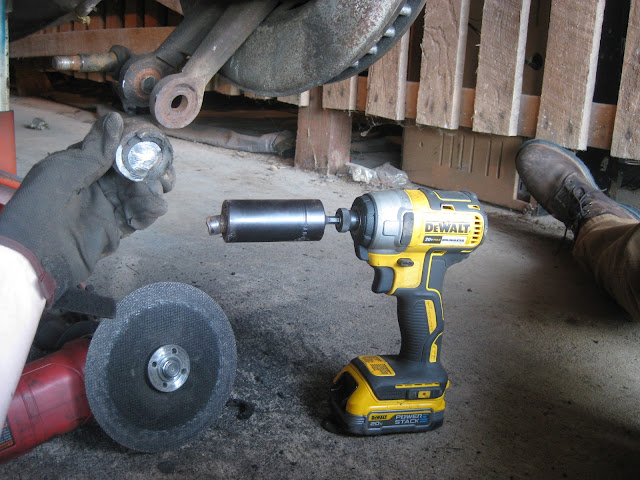The next step was to remove both trailing arms. I only have pictures of the passenger side, as I did it first, but both came off essentially the same. The first steps are to remove the rotors, hard and soft brake lines, the caliper, the parking brake cable and the shock. Fortunately, since I'd just had all new brakes put on, most of these came out easily. The front fitting on the hard brake line was seized to the nut, so I had to loosen the rear and then bend it to spin it free. I'll likely need to get new brake hard lines, and I already have new hoses ready to install.
I'm not sure exactly how old these shocks are, but I'd say that "old" is a good description. I know for a fact they are minimum of 45 years.
I had been soaking these bolts for several days with penetrating oil and found that the nut came off relatively easy. I left it in place while trying to hit the bolt loose. I found that the cotter pin for the trailing arm nut was just slid into the hole and was never bent to lock it into the place. I found the same thing on the cotter pin for the shims. At least the driver's side cotter pins were installed correctly.
I hammered the fire out of this bolt, but it was absolutely not going to budge. Protection on the dog log of the fender is definitely good insurance.
These were my weapons of choice. I've had this upper control arm shaft for years. I kept it when I replaced the suspension on some project years ago. I put the nuts on the end and use it as a driver. I don't use it often, but when I do need it it's often the only thing to get the job done. It also allowed me to keep the hammer a good distance away from the fender.
After a lot of hammering I though the bolt finally came free, but as it turned out it was only moving back and forth with the control arm since the shims were now removed. The bolt itself was very stuck to the bushing and arm, so I had to use a sawzall to cut it out. It's good to remember that you can use a jack to raise and lower the control arm to allowed better reach of the sawzall, either from the top or bottom as needed. I can't say that the job was easy, but considering how tight the spaces are I have to say cutting the bolt out wasn't as bad as I was expecting. After removing the trailing arm assembly the piece of bolt left inside the bushing did not want to come out of the trailing arm at all. I'm afraid trying anything further may damage the arm, and I don't want to do that because I'll need to exchange it as a core for the replacement. From what I have read even if the bearings are good the original grease inside of them should be replaced. In order to do that, the bearings need to be removed. If they are removed, they should be replaced. To replace them, special tools are needed and given the condition of the parking brake and the front bushings, which also require special tools to replace, the easiest solution seems to be replacement. At least I can use my current arms as cores. If I try to do the work myself and damage them, then I would have no core to exchange.
This is a close up of the control arm bushings.
I was glad to find the control arm pocket appeared to be in good shape.
Here's the empty cavity after everything was removed. The driver side added one level of difficulty because the inside shim would not budge and I had to cut the bolt out with the shim in place. I broke a blade on that side but eventually cut through it. While I'm waiting on all of the new parts to come in I'll clean up all
of the exposed frame areas and the control arm pocket. Likely, I'll
scuff all of the areas and then spray them down with Ospho, followed by
primer and paint. I've been keeping a list of parts but now it's time to go over it several times so hopefully I don't leave anything out and have to pay for shipping twice.







































